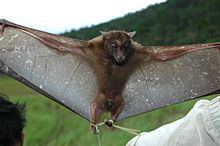Order Chiroptera Rank Species | Phylum Chordata Family Pteropodidae Higher classification Harpyionycteris | |
 | ||
Scientific name Harpyionycteris whiteheadi Similar Sulawesi harpy fruit bat, Lesser musky fruit bat, Hayman's dwarf epaulette, Woodford's fruit bat, Philippine dawn bat | ||
The harpy fruit bat (Harpyionycteris whiteheadi) is a species of megabat in the family Pteropodidae. It is endemic to the Philippines.
Contents
Physical Characteristics
The harpy fruit bat is two-tone in color, being mostly dark brown and lighter brown on its underside. It has no tail but does have a small, fur-covered uropatagium. Its overall length is between 140 and 153 mm. Its canines, premaxillary bones, and upper incisors lean forward causing the upper and lower canines to cross forming nearly right angles when the mouth is closed. The molars are multicuspidate having five or six cusps on each. The lower canines have three cusps (tricuspidate). They weigh between 83 and 142g.
Habitat and Range
Harpy fruit bats are found on the Philippine islands of Biliran, Maripipi, Camiguin, Leyte, Southern Luzon, Mindanao, Mindoro, Negros, Cebu, Masbate, and Samar. They reside in primary (old growth), secondary, and lightly disturbed montane forests. Their range in elevation is between sea level and 1,800m, preferring to stay in habitats of "mid-elevation (around 500m)". As with other fruit bats, harpy fruit bats are crepuscular and "roost in trees" instead of caves.
Diet
These frugivorous bats eat from the viney pandans and some Ficus. The excretion of seeds in the bat's guano helps with the dispersal of these plant species.
Reproduction
Male and female harpy fruit bats reach sexual maturity within a year. There are two breeding seasons, the first is from January to February and the second is from July to August. The females only have one pup at a time with a gestation period of four to five months. Afterwards they lactate for three or four months. Some females breed during both seasons having two pups per year while others only breed during the second season.
Population and Threats
The harpy fruit bat population is thought to be stable. The greatest threat it faces is deforestation. However, this is not thought to be a major threat since the current deforestation within its range is mainly occurring in lower elevations.
